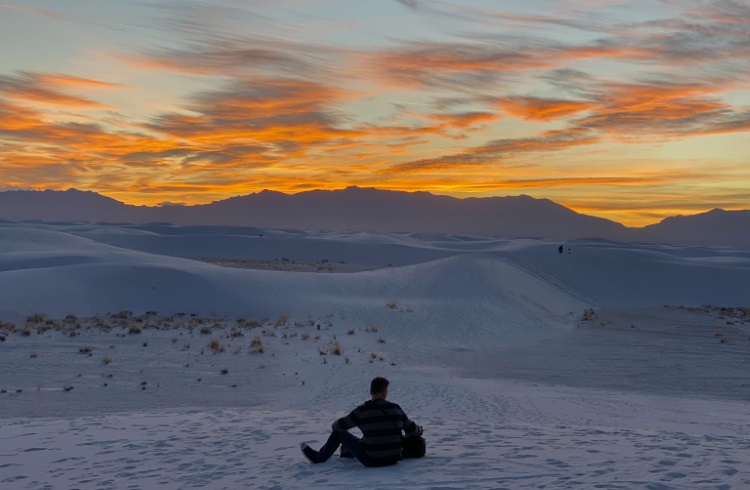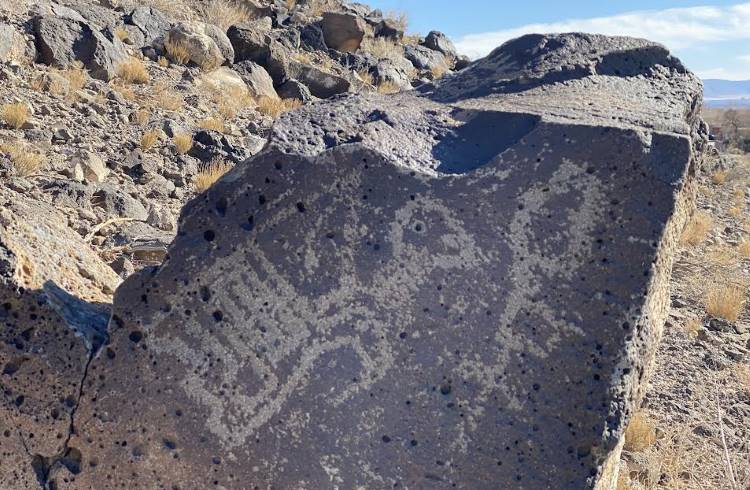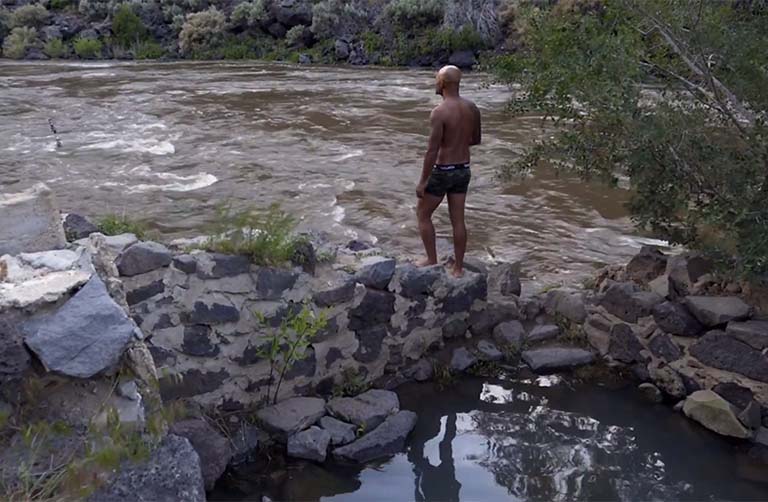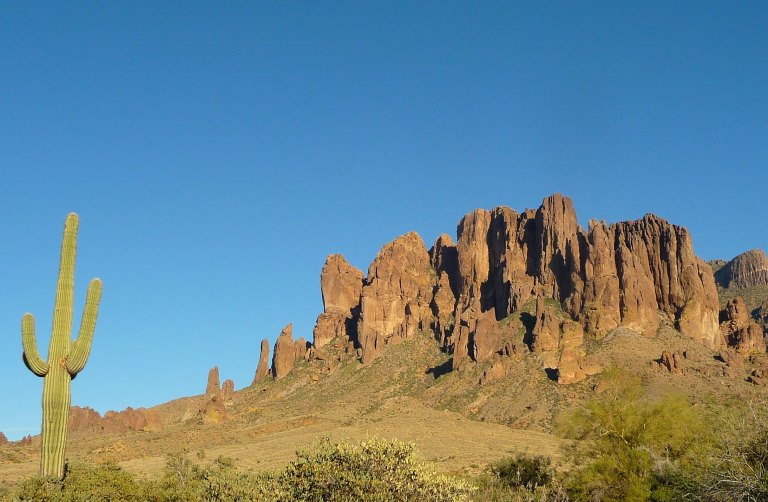Hiking, Hot Air Balloons, and Indigenous History in New Mexico
New Mexico may be known for its hot air balloon festival, but this Southwestern state is also great for hiking, biking, and exploring Native American history – especially in wintertime.
 Photo © Cassandra Brooklyn
Photo © Cassandra Brooklyn
I’ve always wanted to visit New Mexico but since I’m not a fan of dry climates where temperatures can regularly soar over 100°F (38°C), I knew I’d need to avoid the summer. A winter visit meant both manageable temperatures and smaller crowds – double win!
But bear in mind, the state has dramatically varying temperatures and climates depending on where you are, so plan (and pack) accordingly. Las Cruces, which is only about 50mi (80km) from the Mexican border, might be 10-15°F warmer than Albuquerque. In turn, Albuquerque may be another 10-15°F warmer than higher-elevation regions such as Taos, where you’ll also find significantly more snow.
- Sand sledding in White Sands National Park
- Stunning geology at Carlsbad Caverns National Park
- Ballooning, biking, and exploring Pueblo Indian history in Albuquerque
Sand sledding in White Sands National Park
My first stop was White Sands National Park ($25 admission per car or free with an annual pass) located near Las Cruces, in the far south of the State. As Las Cruces doesn’t have a major airport, I flew into nearby El Paso, Texas, where I rented a car and drove the 50 minutes northwest to start my trip. While I was looking forward to hiking in the park (hikes range from ¼-mile boardwalk strolls to full-day desert treks), I was most excited to go sand sledding. Since the soft, snow-white sand gets uncomfortably hot in the summer, winter sledding is far more enjoyable (sleds are available in the gift shop for about $20). Note that unlike snow sledding, you need a steeper hill to get the sled going on sand so make sure you have plenty of clearance at the bottom. Not only was it thrilling to quickly slide down the sand dunes, but it also felt amazing to be sledding – actually sledding! – in warm weather, no cumbersome winter jackets, gloves, or hats required.
The following morning, I rented a bike from Outdoor Adventures to explore the local pecan orchards. The shop staff had great suggestions for how to access the orchard-lined roads without traffic (take Snow Road south then head back north on bike paths along the Rio Grande). Initially, I was sorry not to be exploring the orchards in fall, when the trees are full of colorful leaves but, to my surprise, I discovered that winter is pecan harvesting season, so the trees were still full of nuts. I had never thought twice about how pecans are harvested so it was interesting to see huge, tractor-like machines make their way through rows of trees, whipping up dust storms as they gathered the pecans that “shaker” machines had previously shaken off the trees.
Stunning geology at Carlsbad Caverns National Park
The most direct route from Las Cruces to Carlsbad takes you through northern Texas, so I made a quick pit stop at Guadalupe Mountains National Park. Even if you don’t have time to hike, it’s a stunning place for a bathroom break. Though there are a handful of motels right outside Carlsbad Caverns National Park, I overnighted 20mi (32km) north in Carlsbad, which has more dining options.
Carlsbad Cavern is pretty accessible since you’re able to take the elevator 75 stories down to the “Big Room”, where much of the cavern can be viewed via a mostly-flat trail and boardwalk. I opted to take the 1.25mi (2km) hike down the Natural Entrance Trail. During my hour-long hike, I only ran into two other people (plus a park ranger, who explained a bit of geology) so it felt like I was exploring the giant cavern on my own. Once I reached the Big Room, I was surrounded by thousands of stalagmites shooting up from the ground and stalactites dripping down from the ceiling, occasionally reflecting off small pools scattered around the cavern. You can either hike back up and out or take the elevator. Note that since the caverns (which are the park’s main draw) aren’t open-air, the park is requiring timed entry tickets to limit capacity.

Ballooning, biking, and exploring Pueblo Indian history in Albuquerque
New Mexico’s largest city may be best known for the Albuquerque International Balloon Fiesta, which began in 1972 and now features 500 balloons each October. Though I’m averse to festival crowds, flying sky-high in a hot air balloon was still a priority so I booked a morning flight with Rainbow Ryders ($139 weekdays / $159 weekends). Keep in mind that balloon flights are entirely dependent on the weather so try to schedule your ride early in your stay in case you need to reschedule. On the morning I went out, high winds cancelled the trip, but I was able to go on a successful (and stunning!) flight that afternoon. It was surprisingly silent up there, as we sailed over fields, roads, and subdivisions, gazing at mountains to the west and the nearing sunset in the east.
I didn’t have time to hike the steep, 8mi (13km) La Luz trail up to the top of Sandia Mountain (about 17mi/27km northeast of downtown Albuquerque) so I took the Sandia Peak Tram instead. My weather-altered schedule meant I missed sunset at the top of the mountain (which is supposed to be spectacular) but the morning tram ride was crowd-free, and I was able to enjoy the panoramic view of Albuquerque and explore some of the mountaintop trails, lined with snow-covered trees, before catching the next tram down.
Since I couldn’t leave town without getting in a hike, I added in a visit to Petroglyph National Monument, just 10mi (16km) from downtown Albuquerque. The trails are each only a few miles long or less, but they vary dramatically in terms of elevation and difficulty (ask at the Visitor Center to determine which route may be best for you). And don’t worry, even on the easier routes you’ll still be able to see dozens – if not hundreds – of ancient petroglyphs depicting animals, people, and symbols that Native Americans and Spanish settlers carved into the rocks over 400 years ago.

Though I had a car for my visit, I did most of my exploring in Albuquerque on two wheels. I rented a bike at ROUTES bike shop (which also offers guided bike tours) for a 34mi (55km) solo spin around town. The shop helped me plan my route and gave me a city bike map marked up with points of interest (Paseo del Bosque trail, Los Poblanos lavender farm, Tingley Beach, and the Sawmill Market food hall were my favorites). ROUTES is conveniently located in the Old Town neighborhood so after my ride, I walked around exploring dozens of unique local shops – think Navajo rugs, pottery, handmade soap, chocolatiers, tea, and oil and vinegar.
The Southwest is famous for the rich history and culture of the Pueblo Indians that have occupied the region for generations. Since all the Pueblos remain closed to protect vulnerable populations during the pandemic, the best way to explore their culture and contributions is by visiting the Pueblo Indian Cultural Center in Albuquerque. The museum can be explored in about an hour and the staff is extremely well-informed. Don’t miss breakfast or lunch at the museum’s Indian Pueblo Kitchen, which specializes in traditional Native American foods of the region (I loved the corn, quinoa, and amaranth atole porridge).
Related articles
Simple and flexible travel insurance
You can buy at home or while traveling, and claim online from anywhere in the world. With 150+ adventure activities covered and 24/7 emergency assistance.
Get a quote


No Comments